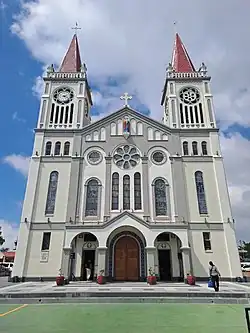Baguio Cathedral
The Our Lady of the Atonement Cathedral, commonly known as Baguio Cathedral, is a Roman Catholic cathedral located at Cathedral Loop adjacent to Session Road in Baguio, the Philippines, and is the see of the Roman Catholic Diocese of Baguio.
| Baguio Cathedral | |
|---|---|
| Our Lady of Atonement Cathedral | |
 The cathedral in February 2023 | |
.svg.png.webp) Baguio Cathedral .svg.png.webp) Baguio Cathedral | |
| 16°24′46″N 120°35′54″E | |
| Location | Baguio |
| Country | Philippines |
| Language(s) | Filipino, Ilocano, English |
| Denomination | Roman Catholic |
| History | |
| Status | Cathedral |
| Dedication | Our Lady of the Atonement |
| Consecrated | July 9, 1936 |
| Architecture | |
| Functional status | Active |
| Architectural type | Church building |
| Style | Neo-Romanesque |
| Groundbreaking | 1920 |
| Completed | July 9, 1936 |
| Specifications | |
| Number of towers | 2 |
| Materials | Gravel, Cement, Steel, Concrete |
| Administration | |
| Province | Nueva Segovia |
| Diocese | Baguio |
| Parish | Our Lady of the Atonement |
| Clergy | |
| Bishop(s) | Sede vacante[1] |
| Rector | Berlynden B. Dao-anis[2] |
| Assistant priest(s) | Marion Joseph S. Nebres |
Dedicated to the Blessed Virgin Mary under the title of Our Lady of Atonement, its distinctive exterior, twin spires and stained glass windows make it a popular tourist attraction in Baguio.[3] It served as an evacuation center under the Japanese Occupation during Second World War.
History
In 1907, a Catholic mission chapel, dedicated to St. Patrick, was established by Belgian missionaries from the Congregatio Immaculati Cordis Mariae. The site where the cathedral currently stands was a hill referred to as Kampo by the Ibaloi people. Construction of the cathedral itself began in 1920 under the leadership of the parish priest, Florimond Carlu. The building was completed and consecrated in 1936. It was dedicated to Our Lady of Atonement.[4]
During the Second World War, the cathedral was an evacuation center, and it withstood the carpet-bombing of Baguio by Allied forces during liberation on March 15, 1945. The remains of the thousands that had died in the bombardment are interred within the cathedral precinct.[5]
In February 1986, anti-dictatorship organizers based in the Azotea Building and in Cafe Amapola on Session Road learned that the People Power Revolution had begun in Manila. Deciding that their locations were too unsafe, they encamped in the courtyard of the cathedral, which was located on higher ground.[6] Thus, it became the site where Baguio residents had gathered to protest the abuses of the Marcos administration—their own contribution to the largely peaceful revolution.[7]
Features
The cathedral has a distinctive façade with a rose window and twin square belfries with pyramidal roofs.[5] Within its large courtyard is a viewing deck that overlooks Session Road and the downtown commercial district of Baguio.
The cathedral is accessible to pedestrians from Session Road via 104-step stone staircase that ends at a Calvary, or through the adjacent campus of Saint Louis University.[8]
A mural on the cathedral grounds, carved by Baguio artist Clinton Pagao Aniversario in 2017,[9] honors the missionaries of the Congregatio Immaculati Cordis Mariae (CICM) who first began Roman Catholic evangelical work in Mountain Province in the 1900s, and were eventually instrumental in the building of the cathedral.[9]
Gallery
 View of the altar
View of the altar A view of the façade at night
A view of the façade at night The cathedral from the stairs with the large Calvary at the terminus of the stone stairs.
The cathedral from the stairs with the large Calvary at the terminus of the stone stairs. Memorial plaque to the carpet bombing victims buried in the cathedral grounds.
Memorial plaque to the carpet bombing victims buried in the cathedral grounds.
See also
References
- "Bishop Bendico bids Baguio farewell". CBCP News. April 28, 2023. Retrieved April 29, 2023.
- "Diocese of Baguio". Catholink. Retrieved April 29, 2023.
- "Baguio Catholic Cathedral". Landmarks and Scenic Sites: The City of Baguio. Archived from the original on April 11, 2008. Retrieved April 19, 2008.
- Cabreza, Vincent (July 11, 2011). "Baguio cathedral celebrates 75 years". Inquirer Northern Luzon.
- Layug, p. 76
- "EDSA '86 up north: The day Baguio turned yellow".
- "Remembering the People's Power Revolution in Baguio - HERALD EXPRESS | News in Cordillera and Northern Luzon". February 23, 2019.
- Layug, p. 77
- Opiña, Rimaliza A. (January 15, 2017). "Mural immortalizes CICM missionaries". Baguio Midland Courrier. Archived from the original on September 25, 2021. Retrieved September 25, 2021.
References
- Layug, Benjamin Locsin (2007). A Tourist Guide to Notable Philippine Churches. Pasig, Philippines: New Day Publishers. pp. 76–77. ISBN 978-971-8521-10-6.